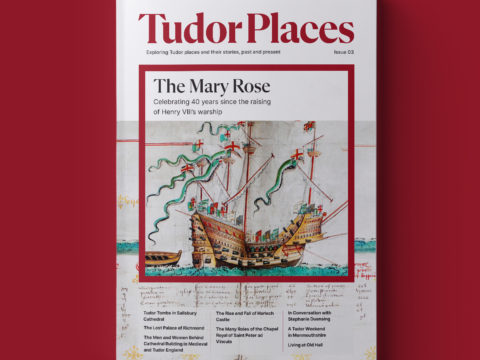The Iconography of Mary I, England's First Crowned Queen Regnant
Chapter 4 : King's Bench Rolls
The final source of imagery Mary used to symbolise her status was the illuminations on the chief justice’s plea rolls for the King’s Bench. These limnings decorated the rotulo primo of the roll which detailed the judicial data for the legal term. The first of these which depicted Mary was the Michaelmas roll 1553.

This beautifully illuminated roll, thought to be the work of Levina Teerlinc and Clement Tusser, depicts Mary enthroned and victorious, a gold cloth of estate hangs behind her as if it was being held up from Heaven. The initial P is filled with blue, silver and gold; they are not only royal colours, but also hint at the Virgin Mary since the Virgin was usually depicted in Marian blue within Catholic iconography. On the left the newly ascended queen is shown being greeted by angels; a reference to the biblical Annunciation where the Virgin Mary was greeted by the angel Gabriel to inform her that she was bearing the Christ child is possible. In the centre is Maria Regina, she sits on a golden throne bearing the coronation regalia. In her right hand she holds the sword of justice, she is a warrior queen as well as judge. Above her is a dove clarifying her divine appointment. This direct correspondence with the Virgin is also seen in literature. Robert Wingfield’s Vitae Maria calls Mary ‘sacred’ and ‘holy queen’ while going as far to suggest that she inspired reverence which only God could rival. John Seton’s Panegyrici in victoriam (1553) and William Forrest’s A Newe Ballade of the Marigolde continues to emphasise Mary’s sacred nature. The golden gown Mary wears not only represents her coronation, but could be the marigold Forrest alludes too while also being the light which has shone out of the darkness of heresy. This roll is unique since it is the only one during Mary’s reign which depicts a story of an event. The following rolls were more traditional in their appearance by having the monarch enthroned.

From the 25th July 1554 Mary was no longer an unmarried virgin defending her people from the evils surrounding her kingdom. She now had Philip, King of Naples and heir to the Spanish Empire. Though he was named king he was merely a consort, he had no legal rights to England and Mary dominated him in all proceedings.
The 1554 Michaelmas roll is the first to depict the newlywed couple; this may be why it is illuminated. The green cloth of estate is embroidered with golden M and Ps and is floral symbolising their marriage and the hope of an heir. Mary’s image has not altered from the previous design; this is evident via the inclusion of the loose hair that showed her virginity; clearly, this was problematic since she was now married. Yet, although Mary may have been married to her husband, she was first married to her country. Her promise to her nation to remain England’s servant is symbolised through the loose hair. Mary holds her coronation regalia in the usual style while Philip wields a sword. Philip welds his military power while Mary holds the true power which is the sceptre. Though this difference may not be noticeable, for Mary the sceptre was far more significant than a sword. Mary is still the dominant partner in the marriage.
This brief introduction to Marian iconography in the first two years of Mary I’s reign has shown that the queen could present herself as a maiden, a mother and as a wife. She used Netherlandish artists to depict her as a Queen regnant while also highlighting her femininity as a wife and as a Catholic saviour. Her coinage allowed her image to cement itself onto all her subjects. The discussion on Marian iconography has only just begun.




